How Work/Care Regimes Contribute to Gender Inequality in Asia-Pacific
VerifiedAdded on 2020/03/23
|6
|2127
|136
Essay
AI Summary
This essay delves into the multifaceted issue of gender inequality within the Asia-Pacific region, focusing on the interplay between work and care regimes. It begins by highlighting the global discourse on gender equality and its economic implications, contrasting it with the reality of unpaid care work predominantly performed by women. The analysis then explores how work/care regimes, shaped by societal values and rules, influence the division of labor and contribute to gender-specific inequalities. The essay investigates the factors driving women's participation in the paid workforce in Asia-Pacific, including economic crises and educational aspirations, while also acknowledging the diverse patterns of female labor force involvement across different countries. It examines the impact of socio-economic, cultural, and political factors, such as education, social norms, and institutional settings, on women's participation. Furthermore, the essay highlights the disparities in work conditions, including the prevalence of part-time and insecure jobs for women, and the burden of unpaid reproductive labor. Finally, the essay concludes by emphasizing the need for change and the importance of reconsidering how work and care are constituted to achieve gender equality, referencing various studies and reports to support its claims.

HOW WORK/CARE REGIMES CONTRIBUTE TO THE
GENDER INEQUALITY IN THE ASIA-PACIFIC
[Type the document subtitle]
[Type the author name]
[Pick the date]
GENDER INEQUALITY IN THE ASIA-PACIFIC
[Type the document subtitle]
[Type the author name]
[Pick the date]
Paraphrase This Document
Need a fresh take? Get an instant paraphrase of this document with our AI Paraphraser
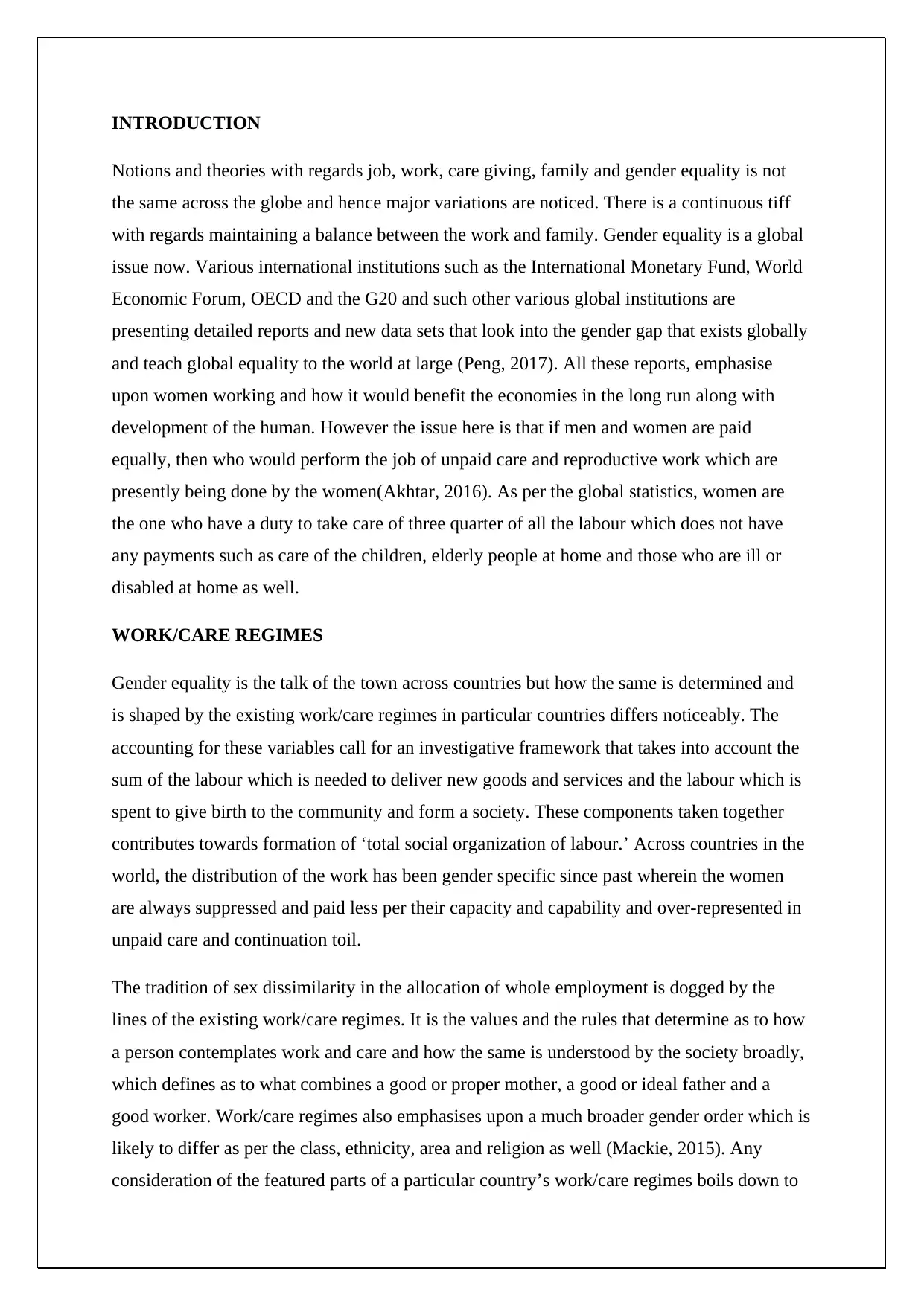
INTRODUCTION
Notions and theories with regards job, work, care giving, family and gender equality is not
the same across the globe and hence major variations are noticed. There is a continuous tiff
with regards maintaining a balance between the work and family. Gender equality is a global
issue now. Various international institutions such as the International Monetary Fund, World
Economic Forum, OECD and the G20 and such other various global institutions are
presenting detailed reports and new data sets that look into the gender gap that exists globally
and teach global equality to the world at large (Peng, 2017). All these reports, emphasise
upon women working and how it would benefit the economies in the long run along with
development of the human. However the issue here is that if men and women are paid
equally, then who would perform the job of unpaid care and reproductive work which are
presently being done by the women(Akhtar, 2016). As per the global statistics, women are
the one who have a duty to take care of three quarter of all the labour which does not have
any payments such as care of the children, elderly people at home and those who are ill or
disabled at home as well.
WORK/CARE REGIMES
Gender equality is the talk of the town across countries but how the same is determined and
is shaped by the existing work/care regimes in particular countries differs noticeably. The
accounting for these variables call for an investigative framework that takes into account the
sum of the labour which is needed to deliver new goods and services and the labour which is
spent to give birth to the community and form a society. These components taken together
contributes towards formation of ‘total social organization of labour.’ Across countries in the
world, the distribution of the work has been gender specific since past wherein the women
are always suppressed and paid less per their capacity and capability and over-represented in
unpaid care and continuation toil.
The tradition of sex dissimilarity in the allocation of whole employment is dogged by the
lines of the existing work/care regimes. It is the values and the rules that determine as to how
a person contemplates work and care and how the same is understood by the society broadly,
which defines as to what combines a good or proper mother, a good or ideal father and a
good worker. Work/care regimes also emphasises upon a much broader gender order which is
likely to differ as per the class, ethnicity, area and religion as well (Mackie, 2015). Any
consideration of the featured parts of a particular country’s work/care regimes boils down to
Notions and theories with regards job, work, care giving, family and gender equality is not
the same across the globe and hence major variations are noticed. There is a continuous tiff
with regards maintaining a balance between the work and family. Gender equality is a global
issue now. Various international institutions such as the International Monetary Fund, World
Economic Forum, OECD and the G20 and such other various global institutions are
presenting detailed reports and new data sets that look into the gender gap that exists globally
and teach global equality to the world at large (Peng, 2017). All these reports, emphasise
upon women working and how it would benefit the economies in the long run along with
development of the human. However the issue here is that if men and women are paid
equally, then who would perform the job of unpaid care and reproductive work which are
presently being done by the women(Akhtar, 2016). As per the global statistics, women are
the one who have a duty to take care of three quarter of all the labour which does not have
any payments such as care of the children, elderly people at home and those who are ill or
disabled at home as well.
WORK/CARE REGIMES
Gender equality is the talk of the town across countries but how the same is determined and
is shaped by the existing work/care regimes in particular countries differs noticeably. The
accounting for these variables call for an investigative framework that takes into account the
sum of the labour which is needed to deliver new goods and services and the labour which is
spent to give birth to the community and form a society. These components taken together
contributes towards formation of ‘total social organization of labour.’ Across countries in the
world, the distribution of the work has been gender specific since past wherein the women
are always suppressed and paid less per their capacity and capability and over-represented in
unpaid care and continuation toil.
The tradition of sex dissimilarity in the allocation of whole employment is dogged by the
lines of the existing work/care regimes. It is the values and the rules that determine as to how
a person contemplates work and care and how the same is understood by the society broadly,
which defines as to what combines a good or proper mother, a good or ideal father and a
good worker. Work/care regimes also emphasises upon a much broader gender order which is
likely to differ as per the class, ethnicity, area and religion as well (Mackie, 2015). Any
consideration of the featured parts of a particular country’s work/care regimes boils down to
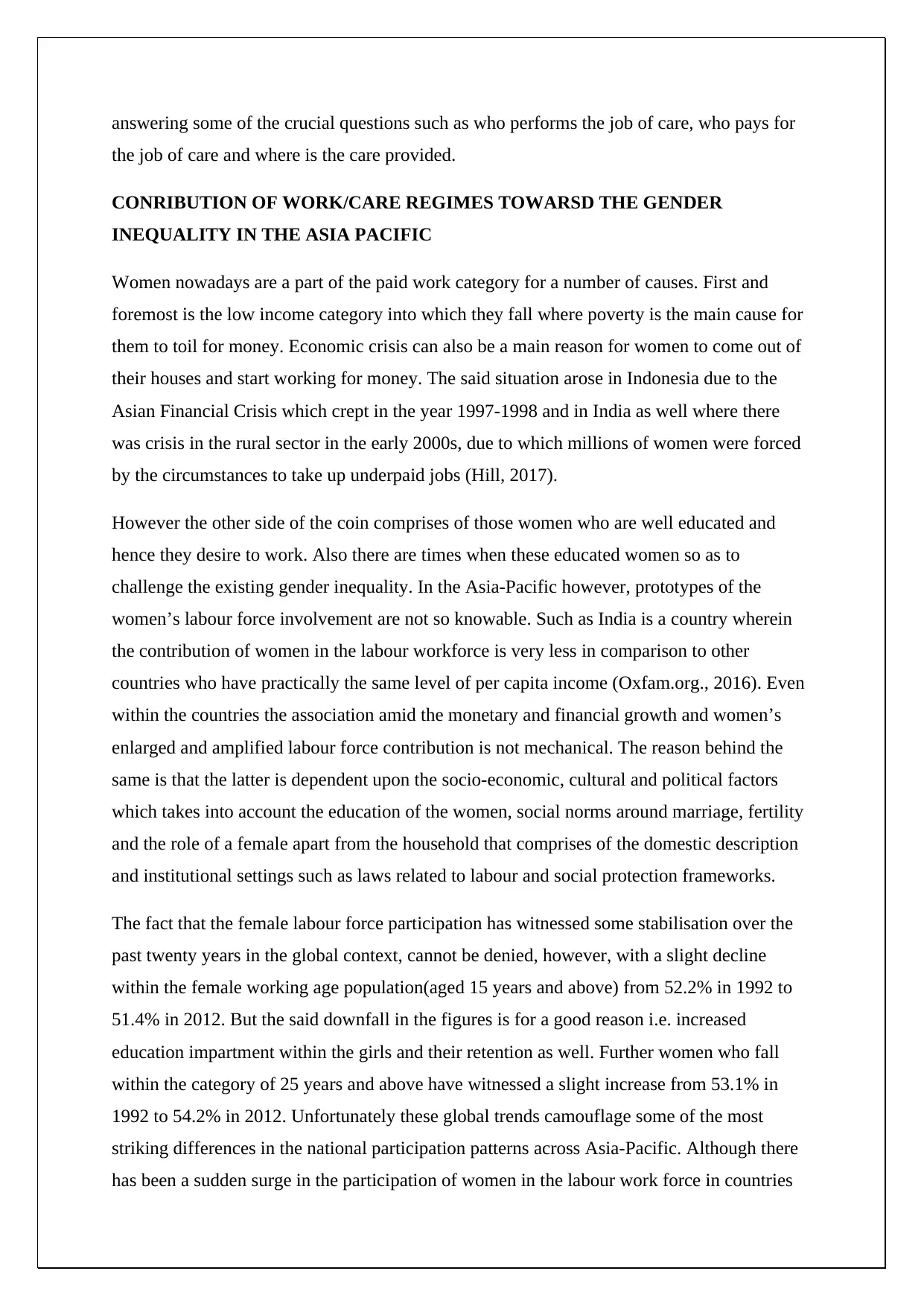
answering some of the crucial questions such as who performs the job of care, who pays for
the job of care and where is the care provided.
CONRIBUTION OF WORK/CARE REGIMES TOWARSD THE GENDER
INEQUALITY IN THE ASIA PACIFIC
Women nowadays are a part of the paid work category for a number of causes. First and
foremost is the low income category into which they fall where poverty is the main cause for
them to toil for money. Economic crisis can also be a main reason for women to come out of
their houses and start working for money. The said situation arose in Indonesia due to the
Asian Financial Crisis which crept in the year 1997-1998 and in India as well where there
was crisis in the rural sector in the early 2000s, due to which millions of women were forced
by the circumstances to take up underpaid jobs (Hill, 2017).
However the other side of the coin comprises of those women who are well educated and
hence they desire to work. Also there are times when these educated women so as to
challenge the existing gender inequality. In the Asia-Pacific however, prototypes of the
women’s labour force involvement are not so knowable. Such as India is a country wherein
the contribution of women in the labour workforce is very less in comparison to other
countries who have practically the same level of per capita income (Oxfam.org., 2016). Even
within the countries the association amid the monetary and financial growth and women’s
enlarged and amplified labour force contribution is not mechanical. The reason behind the
same is that the latter is dependent upon the socio-economic, cultural and political factors
which takes into account the education of the women, social norms around marriage, fertility
and the role of a female apart from the household that comprises of the domestic description
and institutional settings such as laws related to labour and social protection frameworks.
The fact that the female labour force participation has witnessed some stabilisation over the
past twenty years in the global context, cannot be denied, however, with a slight decline
within the female working age population(aged 15 years and above) from 52.2% in 1992 to
51.4% in 2012. But the said downfall in the figures is for a good reason i.e. increased
education impartment within the girls and their retention as well. Further women who fall
within the category of 25 years and above have witnessed a slight increase from 53.1% in
1992 to 54.2% in 2012. Unfortunately these global trends camouflage some of the most
striking differences in the national participation patterns across Asia-Pacific. Although there
has been a sudden surge in the participation of women in the labour work force in countries
the job of care and where is the care provided.
CONRIBUTION OF WORK/CARE REGIMES TOWARSD THE GENDER
INEQUALITY IN THE ASIA PACIFIC
Women nowadays are a part of the paid work category for a number of causes. First and
foremost is the low income category into which they fall where poverty is the main cause for
them to toil for money. Economic crisis can also be a main reason for women to come out of
their houses and start working for money. The said situation arose in Indonesia due to the
Asian Financial Crisis which crept in the year 1997-1998 and in India as well where there
was crisis in the rural sector in the early 2000s, due to which millions of women were forced
by the circumstances to take up underpaid jobs (Hill, 2017).
However the other side of the coin comprises of those women who are well educated and
hence they desire to work. Also there are times when these educated women so as to
challenge the existing gender inequality. In the Asia-Pacific however, prototypes of the
women’s labour force involvement are not so knowable. Such as India is a country wherein
the contribution of women in the labour workforce is very less in comparison to other
countries who have practically the same level of per capita income (Oxfam.org., 2016). Even
within the countries the association amid the monetary and financial growth and women’s
enlarged and amplified labour force contribution is not mechanical. The reason behind the
same is that the latter is dependent upon the socio-economic, cultural and political factors
which takes into account the education of the women, social norms around marriage, fertility
and the role of a female apart from the household that comprises of the domestic description
and institutional settings such as laws related to labour and social protection frameworks.
The fact that the female labour force participation has witnessed some stabilisation over the
past twenty years in the global context, cannot be denied, however, with a slight decline
within the female working age population(aged 15 years and above) from 52.2% in 1992 to
51.4% in 2012. But the said downfall in the figures is for a good reason i.e. increased
education impartment within the girls and their retention as well. Further women who fall
within the category of 25 years and above have witnessed a slight increase from 53.1% in
1992 to 54.2% in 2012. Unfortunately these global trends camouflage some of the most
striking differences in the national participation patterns across Asia-Pacific. Although there
has been a sudden surge in the participation of women in the labour work force in countries
⊘ This is a preview!⊘
Do you want full access?
Subscribe today to unlock all pages.

Trusted by 1+ million students worldwide
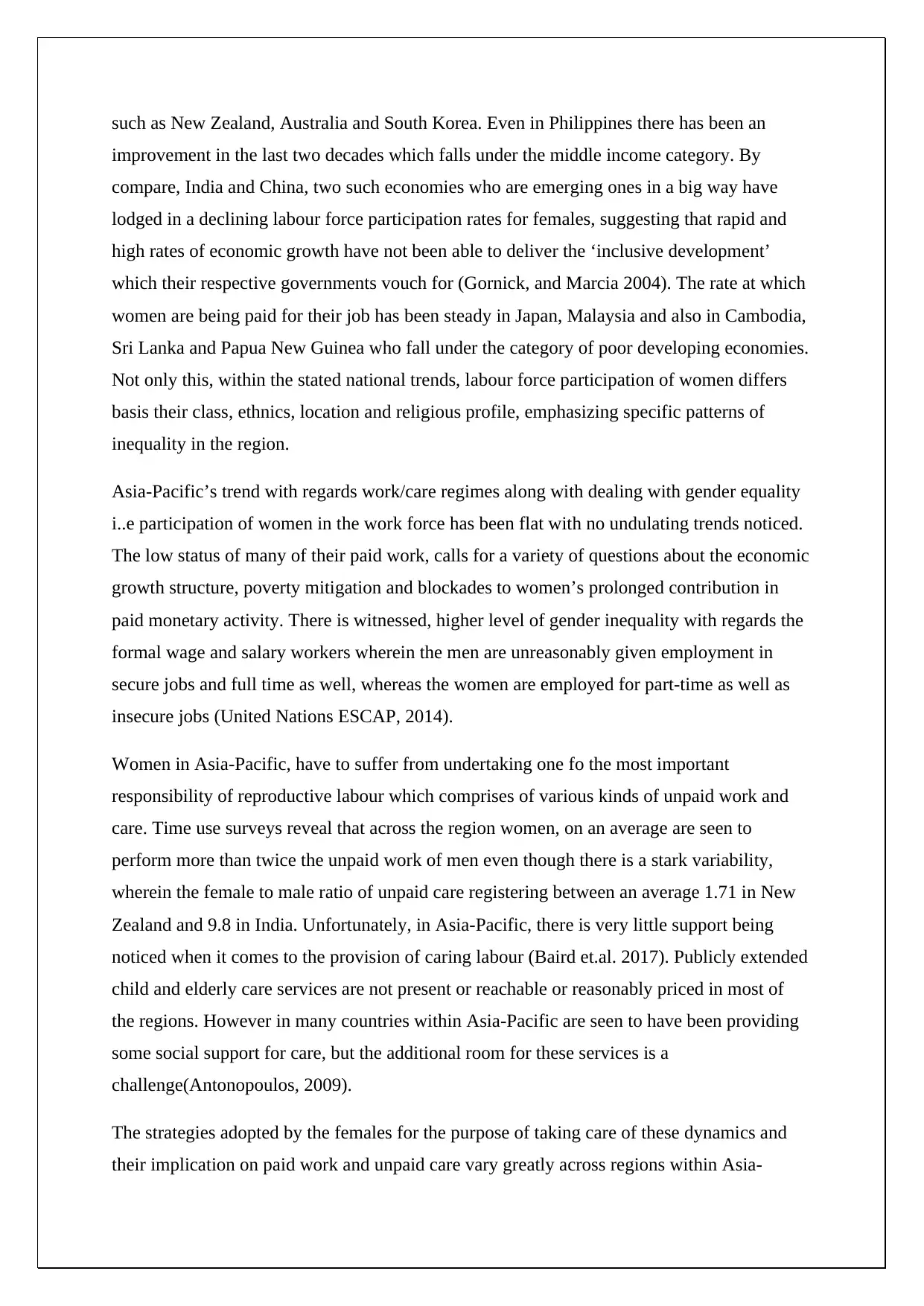
such as New Zealand, Australia and South Korea. Even in Philippines there has been an
improvement in the last two decades which falls under the middle income category. By
compare, India and China, two such economies who are emerging ones in a big way have
lodged in a declining labour force participation rates for females, suggesting that rapid and
high rates of economic growth have not been able to deliver the ‘inclusive development’
which their respective governments vouch for (Gornick, and Marcia 2004). The rate at which
women are being paid for their job has been steady in Japan, Malaysia and also in Cambodia,
Sri Lanka and Papua New Guinea who fall under the category of poor developing economies.
Not only this, within the stated national trends, labour force participation of women differs
basis their class, ethnics, location and religious profile, emphasizing specific patterns of
inequality in the region.
Asia-Pacific’s trend with regards work/care regimes along with dealing with gender equality
i..e participation of women in the work force has been flat with no undulating trends noticed.
The low status of many of their paid work, calls for a variety of questions about the economic
growth structure, poverty mitigation and blockades to women’s prolonged contribution in
paid monetary activity. There is witnessed, higher level of gender inequality with regards the
formal wage and salary workers wherein the men are unreasonably given employment in
secure jobs and full time as well, whereas the women are employed for part-time as well as
insecure jobs (United Nations ESCAP, 2014).
Women in Asia-Pacific, have to suffer from undertaking one fo the most important
responsibility of reproductive labour which comprises of various kinds of unpaid work and
care. Time use surveys reveal that across the region women, on an average are seen to
perform more than twice the unpaid work of men even though there is a stark variability,
wherein the female to male ratio of unpaid care registering between an average 1.71 in New
Zealand and 9.8 in India. Unfortunately, in Asia-Pacific, there is very little support being
noticed when it comes to the provision of caring labour (Baird et.al. 2017). Publicly extended
child and elderly care services are not present or reachable or reasonably priced in most of
the regions. However in many countries within Asia-Pacific are seen to have been providing
some social support for care, but the additional room for these services is a
challenge(Antonopoulos, 2009).
The strategies adopted by the females for the purpose of taking care of these dynamics and
their implication on paid work and unpaid care vary greatly across regions within Asia-
improvement in the last two decades which falls under the middle income category. By
compare, India and China, two such economies who are emerging ones in a big way have
lodged in a declining labour force participation rates for females, suggesting that rapid and
high rates of economic growth have not been able to deliver the ‘inclusive development’
which their respective governments vouch for (Gornick, and Marcia 2004). The rate at which
women are being paid for their job has been steady in Japan, Malaysia and also in Cambodia,
Sri Lanka and Papua New Guinea who fall under the category of poor developing economies.
Not only this, within the stated national trends, labour force participation of women differs
basis their class, ethnics, location and religious profile, emphasizing specific patterns of
inequality in the region.
Asia-Pacific’s trend with regards work/care regimes along with dealing with gender equality
i..e participation of women in the work force has been flat with no undulating trends noticed.
The low status of many of their paid work, calls for a variety of questions about the economic
growth structure, poverty mitigation and blockades to women’s prolonged contribution in
paid monetary activity. There is witnessed, higher level of gender inequality with regards the
formal wage and salary workers wherein the men are unreasonably given employment in
secure jobs and full time as well, whereas the women are employed for part-time as well as
insecure jobs (United Nations ESCAP, 2014).
Women in Asia-Pacific, have to suffer from undertaking one fo the most important
responsibility of reproductive labour which comprises of various kinds of unpaid work and
care. Time use surveys reveal that across the region women, on an average are seen to
perform more than twice the unpaid work of men even though there is a stark variability,
wherein the female to male ratio of unpaid care registering between an average 1.71 in New
Zealand and 9.8 in India. Unfortunately, in Asia-Pacific, there is very little support being
noticed when it comes to the provision of caring labour (Baird et.al. 2017). Publicly extended
child and elderly care services are not present or reachable or reasonably priced in most of
the regions. However in many countries within Asia-Pacific are seen to have been providing
some social support for care, but the additional room for these services is a
challenge(Antonopoulos, 2009).
The strategies adopted by the females for the purpose of taking care of these dynamics and
their implication on paid work and unpaid care vary greatly across regions within Asia-
Paraphrase This Document
Need a fresh take? Get an instant paraphrase of this document with our AI Paraphraser
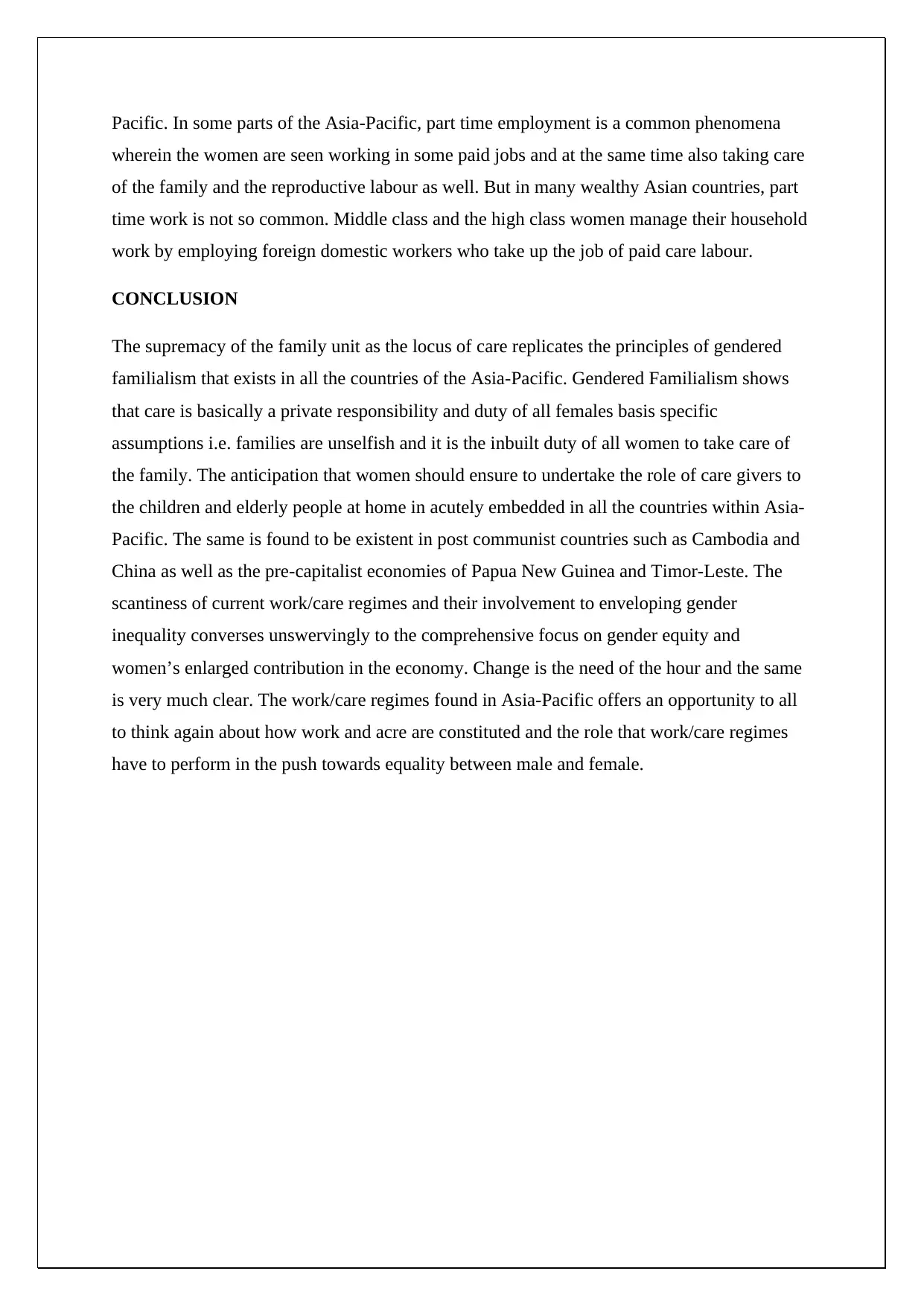
Pacific. In some parts of the Asia-Pacific, part time employment is a common phenomena
wherein the women are seen working in some paid jobs and at the same time also taking care
of the family and the reproductive labour as well. But in many wealthy Asian countries, part
time work is not so common. Middle class and the high class women manage their household
work by employing foreign domestic workers who take up the job of paid care labour.
CONCLUSION
The supremacy of the family unit as the locus of care replicates the principles of gendered
familialism that exists in all the countries of the Asia-Pacific. Gendered Familialism shows
that care is basically a private responsibility and duty of all females basis specific
assumptions i.e. families are unselfish and it is the inbuilt duty of all women to take care of
the family. The anticipation that women should ensure to undertake the role of care givers to
the children and elderly people at home in acutely embedded in all the countries within Asia-
Pacific. The same is found to be existent in post communist countries such as Cambodia and
China as well as the pre-capitalist economies of Papua New Guinea and Timor-Leste. The
scantiness of current work/care regimes and their involvement to enveloping gender
inequality converses unswervingly to the comprehensive focus on gender equity and
women’s enlarged contribution in the economy. Change is the need of the hour and the same
is very much clear. The work/care regimes found in Asia-Pacific offers an opportunity to all
to think again about how work and acre are constituted and the role that work/care regimes
have to perform in the push towards equality between male and female.
wherein the women are seen working in some paid jobs and at the same time also taking care
of the family and the reproductive labour as well. But in many wealthy Asian countries, part
time work is not so common. Middle class and the high class women manage their household
work by employing foreign domestic workers who take up the job of paid care labour.
CONCLUSION
The supremacy of the family unit as the locus of care replicates the principles of gendered
familialism that exists in all the countries of the Asia-Pacific. Gendered Familialism shows
that care is basically a private responsibility and duty of all females basis specific
assumptions i.e. families are unselfish and it is the inbuilt duty of all women to take care of
the family. The anticipation that women should ensure to undertake the role of care givers to
the children and elderly people at home in acutely embedded in all the countries within Asia-
Pacific. The same is found to be existent in post communist countries such as Cambodia and
China as well as the pre-capitalist economies of Papua New Guinea and Timor-Leste. The
scantiness of current work/care regimes and their involvement to enveloping gender
inequality converses unswervingly to the comprehensive focus on gender equity and
women’s enlarged contribution in the economy. Change is the need of the hour and the same
is very much clear. The work/care regimes found in Asia-Pacific offers an opportunity to all
to think again about how work and acre are constituted and the role that work/care regimes
have to perform in the push towards equality between male and female.
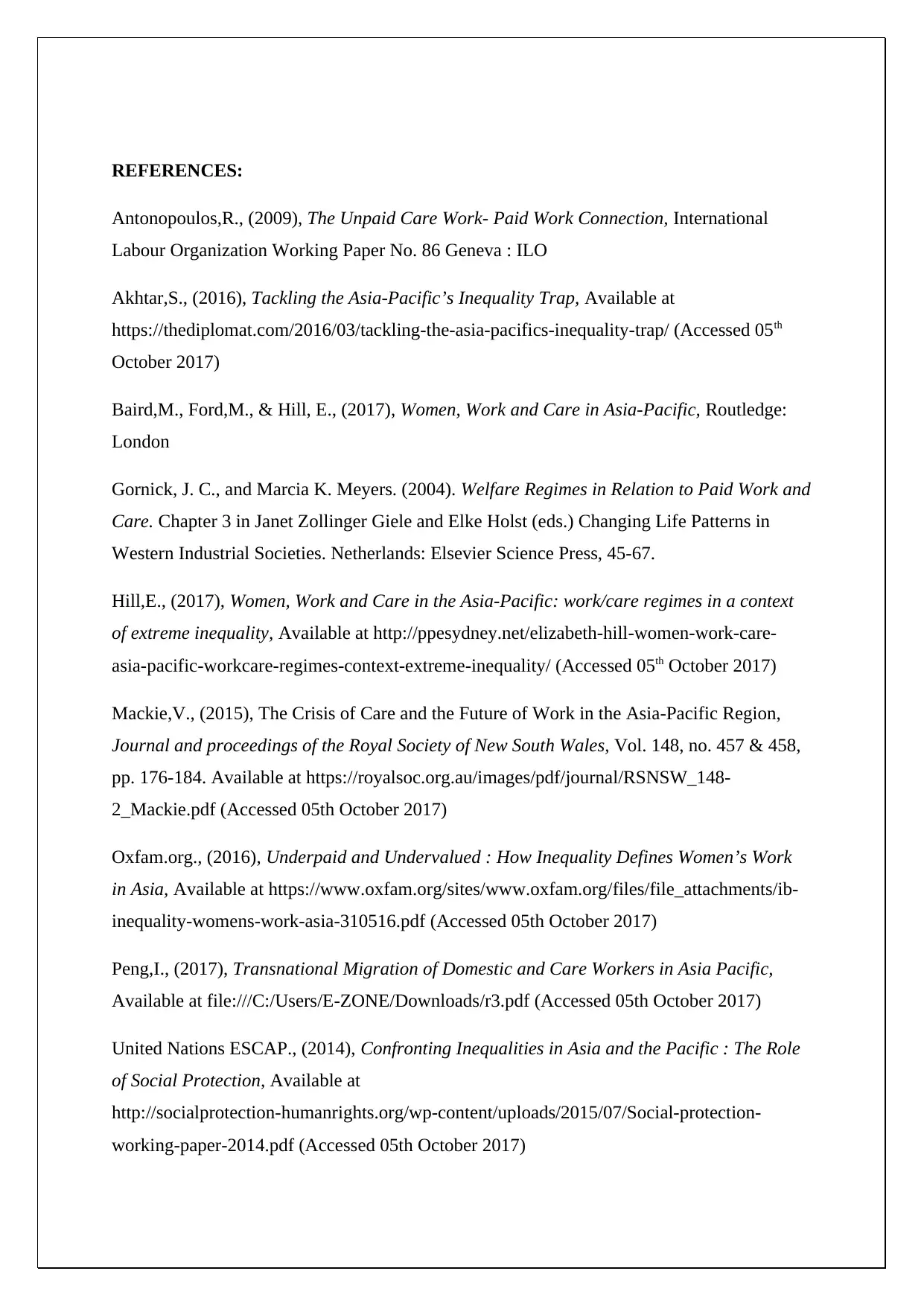
REFERENCES:
Antonopoulos,R., (2009), The Unpaid Care Work- Paid Work Connection, International
Labour Organization Working Paper No. 86 Geneva : ILO
Akhtar,S., (2016), Tackling the Asia-Pacific’s Inequality Trap, Available at
https://thediplomat.com/2016/03/tackling-the-asia-pacifics-inequality-trap/ (Accessed 05th
October 2017)
Baird,M., Ford,M., & Hill, E., (2017), Women, Work and Care in Asia-Pacific, Routledge:
London
Gornick, J. C., and Marcia K. Meyers. (2004). Welfare Regimes in Relation to Paid Work and
Care. Chapter 3 in Janet Zollinger Giele and Elke Holst (eds.) Changing Life Patterns in
Western Industrial Societies. Netherlands: Elsevier Science Press, 45-67.
Hill,E., (2017), Women, Work and Care in the Asia-Pacific: work/care regimes in a context
of extreme inequality, Available at http://ppesydney.net/elizabeth-hill-women-work-care-
asia-pacific-workcare-regimes-context-extreme-inequality/ (Accessed 05th October 2017)
Mackie,V., (2015), The Crisis of Care and the Future of Work in the Asia-Pacific Region,
Journal and proceedings of the Royal Society of New South Wales, Vol. 148, no. 457 & 458,
pp. 176-184. Available at https://royalsoc.org.au/images/pdf/journal/RSNSW_148-
2_Mackie.pdf (Accessed 05th October 2017)
Oxfam.org., (2016), Underpaid and Undervalued : How Inequality Defines Women’s Work
in Asia, Available at https://www.oxfam.org/sites/www.oxfam.org/files/file_attachments/ib-
inequality-womens-work-asia-310516.pdf (Accessed 05th October 2017)
Peng,I., (2017), Transnational Migration of Domestic and Care Workers in Asia Pacific,
Available at file:///C:/Users/E-ZONE/Downloads/r3.pdf (Accessed 05th October 2017)
United Nations ESCAP., (2014), Confronting Inequalities in Asia and the Pacific : The Role
of Social Protection, Available at
http://socialprotection-humanrights.org/wp-content/uploads/2015/07/Social-protection-
working-paper-2014.pdf (Accessed 05th October 2017)
Antonopoulos,R., (2009), The Unpaid Care Work- Paid Work Connection, International
Labour Organization Working Paper No. 86 Geneva : ILO
Akhtar,S., (2016), Tackling the Asia-Pacific’s Inequality Trap, Available at
https://thediplomat.com/2016/03/tackling-the-asia-pacifics-inequality-trap/ (Accessed 05th
October 2017)
Baird,M., Ford,M., & Hill, E., (2017), Women, Work and Care in Asia-Pacific, Routledge:
London
Gornick, J. C., and Marcia K. Meyers. (2004). Welfare Regimes in Relation to Paid Work and
Care. Chapter 3 in Janet Zollinger Giele and Elke Holst (eds.) Changing Life Patterns in
Western Industrial Societies. Netherlands: Elsevier Science Press, 45-67.
Hill,E., (2017), Women, Work and Care in the Asia-Pacific: work/care regimes in a context
of extreme inequality, Available at http://ppesydney.net/elizabeth-hill-women-work-care-
asia-pacific-workcare-regimes-context-extreme-inequality/ (Accessed 05th October 2017)
Mackie,V., (2015), The Crisis of Care and the Future of Work in the Asia-Pacific Region,
Journal and proceedings of the Royal Society of New South Wales, Vol. 148, no. 457 & 458,
pp. 176-184. Available at https://royalsoc.org.au/images/pdf/journal/RSNSW_148-
2_Mackie.pdf (Accessed 05th October 2017)
Oxfam.org., (2016), Underpaid and Undervalued : How Inequality Defines Women’s Work
in Asia, Available at https://www.oxfam.org/sites/www.oxfam.org/files/file_attachments/ib-
inequality-womens-work-asia-310516.pdf (Accessed 05th October 2017)
Peng,I., (2017), Transnational Migration of Domestic and Care Workers in Asia Pacific,
Available at file:///C:/Users/E-ZONE/Downloads/r3.pdf (Accessed 05th October 2017)
United Nations ESCAP., (2014), Confronting Inequalities in Asia and the Pacific : The Role
of Social Protection, Available at
http://socialprotection-humanrights.org/wp-content/uploads/2015/07/Social-protection-
working-paper-2014.pdf (Accessed 05th October 2017)
⊘ This is a preview!⊘
Do you want full access?
Subscribe today to unlock all pages.

Trusted by 1+ million students worldwide
1 out of 6
Related Documents
Your All-in-One AI-Powered Toolkit for Academic Success.
+13062052269
info@desklib.com
Available 24*7 on WhatsApp / Email
![[object Object]](/_next/static/media/star-bottom.7253800d.svg)
Unlock your academic potential
Copyright © 2020–2025 A2Z Services. All Rights Reserved. Developed and managed by ZUCOL.





